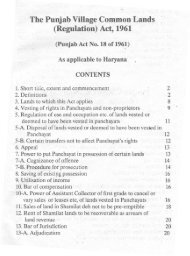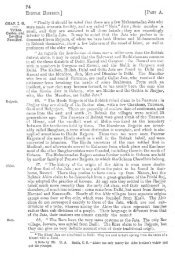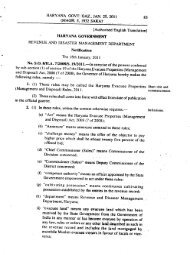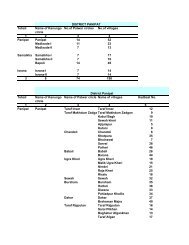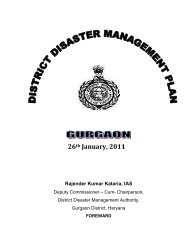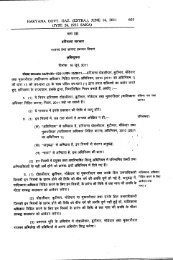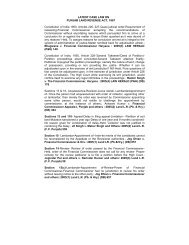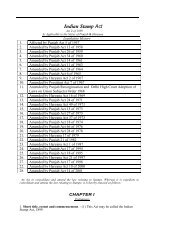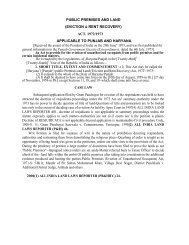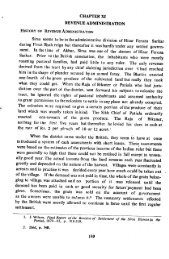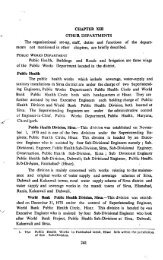chapter - ix - revenue and disaster management department, haryana
chapter - ix - revenue and disaster management department, haryana
chapter - ix - revenue and disaster management department, haryana
You also want an ePaper? Increase the reach of your titles
YUMPU automatically turns print PDFs into web optimized ePapers that Google loves.
Many earn their livelihood from professions other than agriculture<strong>and</strong> industry, mostly from services<strong>and</strong> sales necessary to maintain a certainst<strong>and</strong>ard <strong>and</strong> wayofliving. The growth ofthese occupations depends greatlyon economic development. These occupations, both in rural <strong>and</strong> urbanareas, constitute a significant part of the life of the district. These includemembers of the public <strong>and</strong> defence services <strong>and</strong> all those working in thefields of education, medicine, law, engineering <strong>and</strong> transport. In additionto these fullyorpartly organized services,there are many engaged inearninga livelihood onaself-employed basis. They often work inshops or in theirown houses; some go about hawking their goods or services. In addition,there areafewpeople whoareengaged indomestic services<strong>and</strong> work as cooksbearers, servants, gardeners <strong>and</strong> chowkidars.There has been a vast increase inthe number of jobs inthe public servicesunder the State <strong>and</strong> Central Governments, as alsoIn Local Bodies <strong>and</strong>quasi Government organizations after Independence. Before that as developmentwasofa loworder intheBhiwani district, the growth ofemploymentinthe public sector was insignificant. After theformation ofHaryana <strong>and</strong> thestart oftheperiod ofrapid development asizeablepart oftheworking populationwas able to get jobs in the public sector. The district of Bhiwanicame into existence on December 22, 1972. This was a further impetus.On March 31, 1973, the number of persons employed in public services inadministrative <strong>department</strong>s <strong>and</strong> officesoftheState <strong>and</strong> Central Governments,quasi Government organizations, <strong>and</strong> Local Bodies, was 8,568 (7,660men<strong>and</strong> 908 women). This number roseto 13,674(12,155men<strong>and</strong> 1,519women)byMarch 31, 1975,presenting an increase of 59.6per cent within two years.By March 31, 1977, the number rose to l4,39F (13,205 men <strong>and</strong> 1,186women), presenting an increase of67.6 per cent within four years. It isthus evident that the scope ofexpansion inpublic services during the period1975 to 1977 narrowed down considerably ascompared to the previous twoyears. Thewomen in Bhiwani do not seem interested in public services.1 Its break-up was as follows:- State Government 11,322; central gcv~m~ent 9;Quasi Government 2.356 <strong>and</strong> Local Bodies704.. .
Their number in 1977 came down to 1,186 from 1,519 in 1975, thusrecording adecrease ofabout 22per cent.The persons inthe employofGovernment aregivendearness allowancerelated broadly to the cost of living. Class IV employees are provided withliveries <strong>and</strong> chapals. Loans for the construction of houses under the LowIncome Group <strong>and</strong> Middle Income Group Housing Schemes<strong>and</strong> for the purchaseofvehicles are granted to State Government employees.In December 1970, Government decided onanex-gratia grant <strong>and</strong> otherfacilities forthe families oftheState Government emplOYeeswhodie whileinservice. The grant isequivalent to ten times the last monthly emolumentsdrawn by the deceased employee subject to a minimum of Rs. 5,000<strong>and</strong> amaximum ofRs. 15,000. Other facilities include free medical aid, free educationalfacilities upto the degree level<strong>and</strong> Government employment to aqualifiedmember of the family besides house rent allowance, or the retention ofGovernment house ontheusualrent forayearafter the death oftheemployee.InMarch 1974, theState Government sanctioned anadvance toGovernmentservants (except class I officers) for the celebration of the marriagesof their children. The amount of this advance is 10 months payorRs.l,500 whichever ismore subjecttoaceilingofRs. ~,OOO. Suchanadvancebears interest atthe rate charged from timeto time onanadvance taken fromthe General Provident Fund Account.Some Government Officers are provided rent-free accommodation.This includes the Deputy Commissioner, allthe Sub Divisional Officers(Civil)<strong>and</strong> allthe Tahsildars <strong>and</strong> Naib Tahsildars inthe Bhiwani district. Essentialservices like the railways, police <strong>and</strong> medical <strong>and</strong> public health are usuallyprovided with rent-free residential accommodation. Another such category isjail execlltive staff.Since the number of Government owned houses is limited, generallyonly senior employees are allotted these houses against a deduction of 10percentoftheir pay. Other employeeswhohavenot beenprovided withGovernmentaccommodation are being givenhouse rent onthe basis ofthe populationofthe towns inthedistrict. The rate ofhouse rent admissible atBhiwani,which has been classified as a class II town, is7.5 per cent of thepay of aGovernment employee.Employees in public services are not restricted from formin~ associa,-tions or unions to safeguard recosnised service interest •
The Jats, Ahirs, Rajputs <strong>and</strong> Gujars inthe Bhiwani district contributeda large number of recruits to the different branches ofthe defence servicesduringthe two world wars. During World War II two Victoria Cross(the highest gallantry award in the British Empire) were awarded to Hav.Chhelu Ram (village Dinod) of Rajput Rifles <strong>and</strong> Subedar Richhpal Ram(village Barda) of 4th Rajputana Rifles.A large number of soldiersfromthe district fought in NEFA, Western<strong>and</strong> Eastern areas whenthe Chinese invaded India in 1962<strong>and</strong> during Pakistanhostilities in 1948, 1965<strong>and</strong> 1971. The following defence personnel receivedgallantry awards for distinguished services :-Recipient Resident ofvillagej Award Remarkstahsil------Jammu <strong>and</strong>Kashmir Operation, 1948Lt. Co!.Dharam BadesrajBawani Mahavir Chakra AliveSingh K.heraLt. Co!.Brijpal BaporajBhiwani VirChakra AliveSinghSM/Hony. Capt. FatehgarhjDadri Vir Chakra AliveJug LalRis/Hony. Capt. Neemli/Dadri VirChakra AliveJage RamSMjHony. Capt. Gudana/Dadri Vir Chakra AliveIshwar SinghHav. Sardar Singh Achina/Dadri VirChakra PosthumousLjHav. Mehtab Deosar/Bhiwani VirCahkra AliveSinghNaik SispalSingh BamlajBhiwani VirChakra PosthumousLjNk. Chuni Singh Tigrana/Bhiwani VirChakra AliveChineseAggression, 1962Sub.Nihal Singh SuijBawani Khera VirChakra Posthumous
260 BH!WAN! D!STRICT GAZBTTEERReceipient Resident of villagej Award Remarkstahsil---- -- ---Pakistani Aggression, 1965Rifleman Mathan BaporajBhiwani VirChakra PosthumousSinghChineseBorderAction, 1967Hav. Lakhmi DhananajBa wani VirChakra PosthumousCh<strong>and</strong> KheraPakistani Aggression, 1971Major Sher Singh JhumpajLoharu Vir Chakra AliveNaik Jai Lal GaranpurajBhiwani Sena Medal DoSub. Lt. R.P. TigranajBhiwani Nav Sena Medal DoSinghSqn. Leader A.N. Krishna Colony Vayu Sena Medal DoMehtani BhiwaniHav. KhazanSinghKheri BurajDadri Vir Chakra.DoHav. Daya N<strong>and</strong> Ch<strong>and</strong>enijDadri Vir Chakra PosthumousRamMajor Balbir Singh Pantawas Khurdj Vir Chakra AliveDadriMajor Jai Bhagwan AchinajDadri VirChakra DoSinghNaib Risaldar Hawa NangaljBhiwani Sena Medal DoSinghHav. Jai Lal BadharajDadri Sena Medal DoHav. Ram Ch<strong>and</strong>er JawajDadri Sena Medal DoNaib Subedar Ch<strong>and</strong>enijDadri Mention-in-Des- AliveChhotu Ram patchesLjNaik Ved BadesrajBawani Mention-in- AliveParkash Khera Despatches
Resident ofvillage/TahsilNaik RameshwarDayalALD Jaipal SinghMention-in-DespatchesMention-in-DespatchesSubedar DharamPalHav. Amar SinghBajina/BhiwaniVir ChakraAlive~Naik Dmed Singh(B.S.F.)Dalawas/DadriVir ChakraPosthumousTwo hundred <strong>and</strong> twenty five persons of the district belonging to thearmed forces were reported killed or wounded during the Pakistan Aggressionof December 1971. The details are :-TahsilKilledBhiwani 29Bawani Khera 7Loharu 7Dadri 46----Total: 8990136136225Most ofthe ex-servicemen belong to agriculturist families. The villageswhich have maximum number of ex-servicemen are :-Tahsil Place Number ofVillage/Townex-servicemen1 2 3---------Bhiwani Bapora 212TigraBa 352Dinod 163
261 BitIWANi DISTRICTGAzintilEi.1 2 3Bamla 167Biran 117Baganwala 63Prem Nagar 145Devsar 151Kairu : 91Dhani Mahu 107Jui~ 66Lehgan 90Mitathal 101Bhiwani 217Manheru 119Miran 108S<strong>and</strong>wa 122Dadri Achina 237Baund Kalan 179Chhapar 116Chirya 141Ch<strong>and</strong>eni 141Charkhi Dadri 111Imlota 102Jhojhu Kalan 214
2 l3263Kakrauli Hukmi 107Makrana 94Misri 118Rawaldhi 90Ranila 231Sanwar 144Samashpur 127Dhani-Phogat 109Barwas 76Bisalwas 29Chahar Kalan 54Chahar Khurd 38Gagarwas 31Gothra 45Gopalwas 38Hariawas 52Baliali 10Barsi 14Bawani Khera 191Dhanana 222Kanwari122JSeveralconcessions, have been granted by the State Government toAqned Forces Fer§onnel <strong>and</strong> their famtI!~s,belonging to Haryana who may.,
e killed/disabled/missing during various operations in or outside India :-(A) Ex-gratiaGrantsOfficers Junior OtherCommissioned RanksOfficers(a) Personnel reported killed/disabledwith 50per cent disability or above 7,500 4,500 4,000(b) Personnel with disability between20per cent <strong>and</strong> 50per cent(c) Personnel taken asprisoner ofwarbyenemy~A lump sum of Rs. 500 <strong>and</strong> afurther sum of Rs. 60 per minor/dependent childA lump sum of Rs. 500 <strong>and</strong> afurther sum of Rs. 60 per minor;dependent childA sum ofRs. 1,03,150 wasdistributed as ex-gratia grant to the armedforces personnel <strong>and</strong> their families in the district during the period January18, 1974 to March 31,1977.In addition to the ex-gratfa grants mentioned above, the families/personnel concerned are given monthly pensions, as foIIows,for a period ofs<strong>ix</strong>months from the date of occurrence of the casualty :-Officers Junior OtherCommissioned RanksOfficers(Rs.) (Rs.) (Rs.)(a) Personnel reported killed/disabledwith 50per cent disability or above 250 150 100(b) Personnel with disability between20per cent <strong>and</strong> 50per cent 200 125 75
(C) Educational Grants(1)The children of the aJove mentioned categories of personnelare entitled to free education <strong>and</strong> no feesarecharged from themin schools <strong>and</strong> colleges including professional institutions.(II) For the education of children/dependents monthly grants at thefollowing scale are given per child/dependent 1(i) At theprimary stage 15(ii) At the Secondary stage 35(iii) At college (Arts & Science) stage, J.B.T. class <strong>and</strong>stenography in ITI/Polytechnic Institute. Also tomotor mechanic trainees with qualification belowmatric 75(iv) Motor Mechanic trainees from ITI/PolytechnicInstitute whose minimum academic qualification ismatric 100(v) In the case of technical <strong>and</strong> professional education 125(vi) For higher education abroad 350(vii) The children ofdeceased armed forces personnel already studyinginpublic schools or getting admission to such schools after thedeath oftheir father inactionIncome ofwidow;guardianpermensemUp toRs. 600From Rs. 601toRs.800From Rs. 801toRs. 1,000From Rs. 1,001toRs. 1,200Amount ofeducationallowanceper mensem(Rs.)2,4001,8001. Theexpenditure incurred inthis behalf ismet bythe Chief Secretary toGQvemment,Haryana (in the Defence Branch). The I;>eputyGommissioners are, 4ow~ver,t40Drawin~ a~d Disbursing Officers.
Thesegrants are allowedinaddition towhatever other helpthechildren!dependents may be entitled to in respect of free education, scholarship orother financial assistance especially sanctioned by the Government or aninstitution. 1However, educational concessions are not admissible in casesin whichthese are already being given by the Government of India. These are asfollows :-(i) Complete exemption from tuition <strong>and</strong> other fees (includingcharges leviedfor theschoolbusmaintained byschool<strong>and</strong> actualfarespaid for the railwayspass for students or busfa.re ascertifiedby the Head of Institution concerned.)(ii) Grants to meet hostel charges in full for those studying inboarding schools <strong>and</strong> colleges(iii) Full cost ofuniform where this iscompulsory(iv) Full cost of books <strong>and</strong> .stationery(III) No tuition feeischarged inclassesVItoXI(includingJ.B.T. Classesfrom the children of serving Armed Forces personnel or Exservicemenupto <strong>and</strong> below the rank of non-commissioned officers<strong>and</strong> Junior Commissioned Officersdrawing pension up to Rs. 100or who do not possess l<strong>and</strong> more than 5ac~es(2.02 hectares).CD) RewardstotheWinner orGallantry DecoratiensThe State Government also givescash rewards <strong>and</strong> annuity, as shownbelow, to winners of gallantry awards, viz. Param Vir Chakra, Maha VirChakra <strong>and</strong> Vir Chakra, as under(a) Cash: Rs. 15,000(b) Annuity: Rs. 750for 30yearsThe annuity isgiven for the life of theserviceman or for the life of his wife/widow (if the decoration is earnedposthumously or if the recipient diesbefore hiswife)orfor 30years,whicheverisshorter.1. From January 1971.theabove concessions have also been extended tothe personnelofthe Border Security For••e.Territorial Army anq tqe liOllW Guards Or~aqization belOl~~to aaryaqa.
(a) Cash :Rs. 11,000(b) A::inuity :Rs. 400for 30 yearsThe annuity isgivenfor the life of theserviceman or for the life of his wife/widow (if the decoration is earnedposthumously or if the recipient diesbefore his Wife) or for 30years, whicheveris shorter. ._--(a) Cash : Rs. 4,500(b) Annuity: Rs. 300for 30 yearsThe annuity isgiven for the life of theserviceman or for the life of his wife/widow (if the decoration is earnedposthumously or if the recipient diesbefore his wife)or for 30years, whicheveris shorter.To the winners ofthese awards infuture, the Haryana Government hasdecided to give cash rewards of Rs. 22,500, Rs. 15,000<strong>and</strong> Rs. 7,000 <strong>and</strong>annuity ofRs. 1,000, Rs. 400<strong>and</strong> Rs. 300respectively.The winners of Ashoka Chakra, Kirti Chakra, Shaurya Chakra <strong>and</strong>Sena/Vayu Sena/Nav Sena Medal are given cash reward of Rs. 12,000; Rs.5,000; Rs. 3,500<strong>and</strong> Rs. 3,000respectively without any annuity. It has alsobeen decided to givein future, a cash reward of Rs. 2,000to the recipient ofMention-in-Despatches without any annuity.The awardees ofParam VirChakra <strong>and</strong> Maha VirChakra (Posthumous)of Chinese Aggression 1962,Indo-Pak conflicts of 1965 <strong>and</strong> 1971 are givenmonetary grants ofRs. 22,500 whereas winners ofMaha VirChakra aregivenRs. 15,000 for thepurchase of agricllltural l<strong>and</strong> or urban property. Infuture,the recipients ofParam Vir Chakra <strong>and</strong> Maha Vir Chakra willbegivenmonetatS'grantat the rate ofRs. 1,00,000<strong>and</strong> Rs. 50,000respectively.These rewards/annuities are giventothe members ofthe Armed Forcesof all ranks belonging to Haryana. 1 These benefits are in addition to other1. The personnel ofthe Border Security Force, Territorial Army <strong>and</strong> theHome Guardswho mlY be awarded such gallantry" decorations have also been made entitled to similar cashrewards-<strong>and</strong> annuity.
ex-gratia grants that may beadmissible otherwise. In caseofmore than onegallantary decoration, the awardee isentitled to full cash rewards for eachdecoration separately. In the case of posthumous decoration, the rewards/annuities are given as under :(i) Fifty per cent is given to the widow/dependent children withimmediate effect.(ii) Fifty per cent is given to the parents provided they were dependentonthe recipient ofthe decoration. Otherwise this portion of the reward/annuity is given to the widow/dependentchildren.(iii) Where widow/dependent children <strong>and</strong> dependent parents donot exist,the payment ofcash rewards <strong>and</strong> annuity ismade tothe dependent brother(s) <strong>and</strong> sister(s)provided theywereresidingwith the deceased personnel during his lifetime <strong>and</strong> in the caseof females, annuity isto be paid till her/their marriage.(iv) Where the deceased personnel is survived by his dependentparents only, then parents are given 100 per cent of suchgrant,etc.Five per centvacanciesinClassI<strong>and</strong> II posts <strong>and</strong> 28per cent of vacanciesin Class III <strong>and</strong> IV posts have been reserved for ex-servicemen. Thisreservation is utilized in the following order :-1. (a) Disabled ex-servicemen l with disability between 20per cent to50 per cent.(b) Up to two dependents (this includes wife/widow/dependent sons/daughters) of killed/disabled ex-servicemen with disability 50'per cent <strong>and</strong> above.(c) Other ex-servicemen.2. Relaxation ineducational qualifications <strong>and</strong> age are alsoallowedtoex-servicemen for their re-employment in civil positions.These concessionsarealsoallowedtoex-servicemen bythesemi-Governmentorganizations, public sector undertakings <strong>and</strong> local bodies.1. The expression 'disabled ex-servicemen' means ex-servicemen who while servinginthe armed forces, were disabled in operations against the enemy or indisturbed areas.
(a) Reservation of 15per cent of the plots in the Industrial Area/Industrial Development Colonies for the establishment ofindustries.(b) Allotment ofresidential <strong>and</strong> commercial plots to the war widows<strong>and</strong> disabled soldiers at the reserved price. Payment isreceivedin instalments with a nominal interest of 2per cent.(c) State Government has given additional pension from Defence<strong>and</strong> Security ReliefFund to the widows<strong>and</strong> children (upto threechildren) of servicemen dying in service without being battlecasualties, disabled exservicemen whose disability isattributableto service<strong>and</strong> their children at the following rates from March1, 1975 .-Rs. 50per month up to 20years(ii) Junior CommissionedOfficer'schild(iii) Other rank's child(iv) Childlesswidow(v) Childlessdisabledex-servicemenRs. 40 per month up to 20 yearsRs. 30per month up to 20yearsRs. 30per month up to re-marriage or tilllifeRs. 30 per monthUp to March 31, 1977,Rs. 79,278was distributed to 58families of theBhiwani district.Two funds, (1) Post War Services Reconstruction Fund, <strong>and</strong> (2)Special Fund for Reconstruction <strong>and</strong> Rehabilitation of Ex-servicemenhave been created bythe Government ofIndia for the v,.elfare of ex-servicemen<strong>and</strong> their dependents.Post War Serv;ces Reconstruction Fund.-This fund was raised duringWorld War II for the benefit ofex-servicemen of <strong>and</strong> below the rankof non-commissioned officers<strong>and</strong> their dependents. The money from whichthe fund had been built wasto beused for the collectivebenefitofthose whohad served in the ranks or as non-combatants in the Defence Services duringWorld War II or thereafter. The purposes for which the fund is beingutilized(a) Grant of stipends to the sons/wards of beneficiary ex-servicemen
(e) to grant loans to individual ex-servicemen for starting industrieior business undertakings; <strong>and</strong>J271(f) to do all other things to promote measures for the benefit ofexservicemen<strong>and</strong> their dependents.The income from the fund isbeing mainly utilisedfor grant ofstipendsto ex-servicemen/their dependents <strong>and</strong> grant ofloans to ex-servicemenfor theirrehabilitation. Ever sincethe operation of the fund in the State, an attempthas been made to make clear cut demarcation in regard to the benefits to begiven to ex-servicemen/their dependents from the Special Fund/Post WarServices Reconstruction Fund in order to avoid over-lapping <strong>and</strong> duplication.Loans are being granted from the Special Fund only. Stipends to ex-servicemen/their dependents eligibleunder the Special Fund Scheme are also beinggiven from the Special Fund. Dependents with academic qualification ofMatric/Higher Secondary for technical, vocational or agricultural educationare granted stipends from the Special Fund whereas under matric dependentsstudying in the I.T.I.s <strong>and</strong> for general education are given stipends from thePost War ServicesReconstruction Fund.EDUCATIONALPERSONNELwasDuring 1976-77,the number of school teachers in the Bhiwani districtMale Female Total 'b'i---- ----Trained Un- Trained Un- Trained Un- ~trained trained trained:--- ---High/Higher/MultipurposePost BasicSchools 1,700 22 350 3 2,050 25Middle/Senior BasicSchools 518 134 2 652 2PrimaryIJuniorBasicSchools 913 241 1,154Total: 3,131 22 725 5 3,856 27Teachers in high/higher secondary schools Were 53.4 per cent of the.total number of teachers, whereas inmiddle/senior basic shools <strong>and</strong> primaryljunior basic schools the percentage was 16.8 <strong>and</strong> 29.7 respectively. AccordjD~to qualifications, 26.6 per cent of t!l9 teachers were graduates, 73.4 per
cent either matriculates or under matriculates or under graduates. The numberof untrained teachers was ne;;ligible. The qualification details are :Males Females Total PercentagetototalDegreeInter/Matric/N on-matriculates912 120 1,032 26.62,241 610 2,851 73.43,153 730 3,883 100.0Women teachers comprised 18.8 per cent ofthe total number. Socialconditions do not encourage unmarried girlsparticularly to go for work invillage schools. Even male teachers tend to reside in nearby urban areasbecause ofthe scarcity of suitable residential accommodation <strong>and</strong> other facilitiesin the villages. In these circumstances, teachers living away from theirplace ofwork cannot make afullimpact on the lifeofthe villagecommunity.The pay scalesof teachers inprivate institutions are the sameas oftheteachers in government institutions. The scales ofpay of teaching personnelin the privately managed institutions were revised
(I) PUBLIC WORKS DEPARTMENT(a) Public Health1. Public Health Circle, Bhiwani2. Public Health Division No.1, Bhiwani3. Public Health Division No. II, Bhiwani(b) Buildings <strong>and</strong> Roads2. Bhiwani Irrigation Division, Bhiwani3. Hisar Division, W.J.c., Hisar4. Western Yamuna (Jumna) Canal West Circle, Rohtak5. Hisar Bhakta Canal Circle, Hisar6. Jui Canal Division, Bhiwani1. Theirrigation circles/divisions donot coincide with the boundaries ofcivildistrictbut are determined by th~ irrigation channels which these administer. The list, therefore.incIud.esalltheoffices ofIrrigation Department concerned with the Bhiwani distri~t. althou~som~ 0f th~m are locat~d outside the district.
1. Haryana State Electricity Board Operation Division, Bhiwani2. Haryana State Electricity Board Construction Division,Bhiwani3. Haryana State Electricity Board Operation Division, CharkhiDadriA few persons also work as contractors, architects <strong>and</strong> surveyors.Some engineers have been employed by the textile industry. Thedistrict has the unique distinction of having the only Technological Instituteof Textiles in the State located at Bhiwani, which imparts training in tex.tileengineering.TRANSPORTTransport requires the services of people working on railways, buses,motor vehicles,tempos, rickshaws, tongas, bullock carts <strong>and</strong> camel carts. In1961,1,814persons were employed inallthese transport activities. The numberrose to 2,463in 1971. In March 1977,the number rose to 3,274.After the Partition, the rickshaw appeared on the scene. Most ofthe men engaged in pulling rickshaws get these on hire <strong>and</strong> pay Rs. 2toRs. 3a day to the owners. Their economic condition is not satisfactorysince on an average they earn onlyRs. 200to Rs. 300per mensem. Risingprices have affected adversely this section of the people. Banking agencieshave financed some rickshaw pullers in purchasing rickshaws.Asfor tongas, their number is few in this district. The dem<strong>and</strong> isno longer brisk inth~ urban areas ofthe district duetothe ready availabilityof rickshaws atcomparitively lower rates; the cost<strong>and</strong> maintenance ofa rickshawismuch smaller; the rickshaw also takes the passenger to his residenceevenin narrow lanes. Tongas are used for longer distances into thecountry-side. The use of passenger tempos has gained popularity in recentyears again at the cost of the tonga.The economic <strong>and</strong> social status of Government transport employeesismuch better than that of rickshaw pullers <strong>and</strong> tonga drivers. There havebeen remarkable changes in transport activities after the formation of thenew district of Bhiwani. The number of buses <strong>and</strong> routes have increased..'(his has adversely affected the number as wellas income of tempo owners..-At present the number of three-wheeled tempos carrying passengers is only
70in the district. Before the reorganization of the district this number washigher. Thenumber of four wheeledtempos, whichcarrygoods from oneplaceto another, isabout 75inthedistrict. Thistype of vehicleiscalledMatador.It has been gaining much popularity ingoods transport. These metadors aremostly financed by the banks.Transport workers, Drivers, Conductors, Cleaners, etc., are employedboth in the public <strong>and</strong> private sectors.Barbers.-Their number in March 1977 was2,750 inthe district. Thisalso included hair dressers <strong>and</strong> related workers. In urban areas the oldpractice ofa family barber isalmost extinct. People pay barbers for serviceat home or goto a hair cutting saloon. Hair cutting charges varyfrom Re. 1toRs. 1.25 <strong>and</strong> shaving chargesfrom 30to40 paise. The barbers inBhiwanitown havetheir ownunion which enjoins upon itsmembers tofollow certainrules <strong>and</strong> regulations in economic <strong>and</strong> social ;matters.In villages, however, the old practice of a fa~ily barber is in vogu:.H; can still b~ s~n at social ceremonies <strong>and</strong> otht:rwise. He attends hisyajmans (patrons) at their residence <strong>and</strong> gets remuneration in kind at harvestingtime.The wifeofthe barber callednain does some sort ofhair cleaning<strong>and</strong>hair dressing for women invillages<strong>and</strong> her presence on certain social<strong>and</strong> religious ceremoniesis necessary. In old timesthe nai (barber) used tobe a messenger from the bride's family to the bridegroom's family <strong>and</strong> viceversa. He played a veryimportant role inthe arrangement ofmarriages, <strong>and</strong>the barber's wife (nain) usedto accompany the bride after the marriage to herin-laws. This pratice has since fallen into diSUse.Washermen.-In March 1977, their number was 274 (218 men <strong>and</strong> 56women). It included dhobis, launderers, drycleaners <strong>and</strong> pressers. Washermenmostly servetheurban areas; thevillagersdotheir own washing. Washermencollectclothes fromthe residenceoftheir customers <strong>and</strong> generally charge30'paiseper article ofclothing. However, the chargesfor a bed-sheet, khes;carpet are almost double orthree timesthisrate. The launderers run regularshops <strong>and</strong> do not undertake home delivery. They charge higher rates thanthe dhobis. Their quick <strong>and</strong> efficientservice ensures good customers. Thelaundry owners either USewashing machines oremploy dhobis for washing <strong>and</strong>
JBIDW ANI DISTRICT GAZllT'tEERadditional persons for ironing. 'The laundry business has affectedthe commondhobi who often prefers employment with a launderer. They switchover to dry cleaning in winter. Dry cleaning has no doubt b~come a profitablebusinessasthere are asmany as 137 persons engagedinthis business.An automatic st~am pressing plant setup byJug Mug Dry Cleaners, SaraiChopta, Bhiwani, isthe latest addition to this trad~. The drycleanerschargeaccording to a scheduk of rat~s,shown below,f<strong>ix</strong>ed bytheDistrict BhiwaniDry Cleaners Association, BhiwaniRate per piece(March 31,1977)(Rs.)Gents Suit(woollen)Gents Coats (woollen)Gents Pants (woollen)Shawl,Jersey,Jacket Shirt, Baby Coat (wooll~n)Blank~t(woollen)Ches~r (woollen)LadiesSuit (woollen)5.003.002.002.005.006.003.002.503.001.50Mumsf l(woollen)Achkan (w
complete change in the urban areas <strong>and</strong> the people increasingly wear moderntypes of clothing, once considered we
Their number on March 31, 1977,in the Bhiwanidistrict was only335,of whom 105werewomen. With increasing development, the districthasmore servantsin evidencenow.A domestic servantispaid betweenRs.50<strong>and</strong>Rs.80per monthplusboard <strong>and</strong> lodging. At marriages,or otherimportant festivalsorceremonies,theyare paid both incash<strong>and</strong> kind. The Indian situtation<strong>and</strong> atmospheredonot usuallyfavourspecialisedjobs. A single domestic servantengagedinahouseholdmayberequiredtopurchaseeatablesinthe market,cookfoodathome,cleantheuseddishes<strong>and</strong> plates,scrubutensils,sweepthehouse, makethe beds<strong>and</strong>infactdoanythingelseatthe biddingofthemaster. Somewomenalso workaspart-timedomestic servantsinanumberofhousesfor cleaningutensils,sweeping<strong>and</strong> helpingthehouse-wivesintheir dailychores. Suchapart-time domestic workergets about Rs. 15to20 permonth.In urban areas,theuppermiddleclass<strong>and</strong>more well-to-dopeopleoftenemploydomestic servants. Ifboththe partnersareinservice,adomesticservantisemployedtolookaftertheirhouse<strong>and</strong>children. Inruralareas,hardlyanyfamilyemploys a servantfordomesticwork. Most ruralwomenattendto their domesticwork themselves. The halis besidesattending to agriculturaloperations,do domestic choresfor their masterS'. Thesepersons, whoare generallyl<strong>and</strong>less labourersarepaid at f<strong>ix</strong>ed proportion of the harvest(about 1/5thofthe total harvest).SELF-EMPLOYED PERSONSThe canvasfor work of self-employed personsiswide. It includesjulahas (weavers), mochis (cobblers), sweepers, thatheras (utensil makers),shoe makers,potters, bullock-cartdrivers,h<strong>and</strong>-cart pullers,hawkers,pvndas(priests)a:ndallpersonswhoworkfortheirlivingbyprovidingtheirindividualservicesorgoodsondem<strong>and</strong>. Thereareshopsofallkinds, halwai shops,panbidi shops,shops manufacturingor/<strong>and</strong> sellingaeratedwater/softdrinks,shopsdealing in grocery,vegetables<strong>and</strong> fruit shops. Bakeriesselltheir productsdirectly or through agents. Goldsmithsmanufacture gold <strong>and</strong> silverornaments.Shops dealingingeneral merch<strong>and</strong>ise,oilmen's stores<strong>and</strong> consumergoods <strong>and</strong> novelitiesalso cater to varying needs. Changingconcepts <strong>and</strong>circumstances make scope for new occupations. Take for example,thepublic eatinghouses. The growing habit of eating outside has ledtotheestablishment ofa largenumberof tea stalls, snack bars <strong>and</strong> dhabas.Like-wise,a desiretowear st<strong>and</strong>ardisedclothes hasprompted theopeningof
shops dealing in ready-made garments. There are 25 shops of ready-madegarments in the district. The incrp3.singuse of bicycles, auto-cycles, cyclerickshaws,scooters <strong>and</strong> motor-cars has been responsible for attracting peopleto take to the business of cycle <strong>and</strong> auto-repairing. Bicycle repairers arefound in every nook <strong>and</strong> corner of the district. Businessisusually brisk forthem all the year round. Automobile repairers are confinedalmost entirelyto urban areas. There are 60suchshops in the district.The time oldjulahas tweavers), mochis (cobblers), potters <strong>and</strong> sweepersare spread throughout the district <strong>and</strong> serve both the rural <strong>and</strong> urban com.munity. Most ofthem in rural areas help familiesintheir agricultural acti·vities <strong>and</strong> perform their customary professional services on the occasion ofmarriages <strong>and</strong> other ceremonies. The mochi (cobbler) with equipment hang.ing bythe shoulder in abox, may usually beseenhawking for his servicesInthe streets. Cobblers usually attend tothe repair mending <strong>and</strong> recondition·ingof shoes. Others who make new shoeshave their own shops. Thereisa shoe-making factory ofHaryana Footwear Corporation making all typesofshoes, s<strong>and</strong>als <strong>and</strong> c1zappalsfor women ~.ndmen. The potters make ordinaryvesselsmostlyfor the useof villagers. The earthen pitchers <strong>and</strong> surahis,because oftheir property to cool water, are sold inlargenumber during thesumliler season both inthe urban <strong>and</strong> rural areas. The sweepersengagedincleaning hous-;:sinurban areas, geta fewrupees per month inaddition to oneor two chapatis daily or weekly<strong>and</strong> occasionally small giftsin cash or kind,on festivals <strong>and</strong> ceremonial occasions. In recent years, owing to better employmentfacilities <strong>and</strong> privileges, some sweepers have been shifting over toservices in Government offices<strong>and</strong> private organizations.Th.ltheras (utensil makers) <strong>and</strong> lohars (blacksmiths) of Bhiwani <strong>and</strong>Loharu are reputed for their brass utensils <strong>and</strong> iron containers. The tokni(brasscouldron) of Bhiwani isa popular utensil of the area.The h<strong>and</strong>-cart p~dlars <strong>and</strong> hawkers go about the towns <strong>and</strong> villageshawking their goods. The goods whichthey sell include among other articlesof daily use, vegetables, fruit, eatables, general merch<strong>and</strong>ize, crockery, cloth<strong>and</strong> toys.A typicalclassof Hindu priests (p<strong>and</strong>as <strong>and</strong> purohits) isfound scatteredall over the district. They perform the customary religious practices, forthe families to whIch they are traditionally attached <strong>and</strong> make living onthis. DExcept )n very)mall :villages, a tea-stall .ofsome kind has made its
appearance. The smaller ones,managed bya singleperson ana servingonlytea, are generally shabby. The bigger ones,which also serve other hot <strong>and</strong>cold bewerages<strong>and</strong> some edibles,are more presentable inappearance <strong>and</strong> aremanaged by more than one person.In towns <strong>and</strong> big villages there areshops dealing ingeneral merch<strong>and</strong>ise.The goods onsale comprise toilet articles(combs,hair brushes, mirrors,etc.), soaps, oils, tooth-pastes, tooth-brushes, shoe polishes, hosiery articles,readymade garments <strong>and</strong> sundries of daily use. They have a flourishingbusiness. With the riseinthe st<strong>and</strong>ard ofliving,there isan increasing dem<strong>and</strong>for consumer goods <strong>and</strong> in fact new shops keep cropping up.Every town <strong>and</strong> bigvillageofthe district hasanumber of halwai shops.In the old days their familiar sweetmeat preparations were laddus <strong>and</strong> julebisThe development ofcommunications, <strong>and</strong> anincreasing contact with the otherparts of the country, have introduced some new sweetmeat preparations likegulab jamans, rasgullas, barti <strong>and</strong> various kinds of halwas. In urban areas,sweetmeats prepared from milk are more popular. These shops are oftenone-man units but several do employ two or three or even more personsaccording to requirements. This business provides employment throughoutthe year..Pan-bidi stalls in urban areas are tiny booths which are a familiarsight throughout the district. These one-man units intowns, which usuallysell cigarettees, alsoserveaschopals invillages. Theybecome social centresforpeople whostop tolisten toradio broadcasts <strong>and</strong> recorded filmmusic <strong>and</strong>talk about current events.In the lastfewyearsbottled softdrinks havebecome popular <strong>and</strong> it isfashionable to drink these with a straw put into the bottle. Such drinksare imported from Delhi. In fact soft drinks are freely offeredat all bigfunctions' <strong>and</strong> marriage celebrations. A few small local units at BhiwanijCharkhi Dadri also prepare aerated drinks for local consumption.A number of grocershopsaretobe found in every locality. Althoughthese are one-man establishments, generally ahelper is also engaged. Everytown has a number of shops sellingvegetables <strong>and</strong> fruit. Enterprising personswithsmall capital carry vegetables<strong>and</strong> fruit ontheir rehariS (h<strong>and</strong> carts)<strong>and</strong> sell thesetocustomers at their doors.Itisnot unusual tocome acrossa bakery evenina small town. Thesehave gained popularity owingt9 the dem<strong>and</strong> for their ready-made products.
Such establishments are mostly one-man units. The proprietor may engageoneortwopersons for preparing products asbread, cakes, biscuits, pasteries,etc. The bakery units selltheir products in wholesale as wellas in retail.Usuallythe grocer<strong>and</strong> hawkersbuythese products wholesale <strong>and</strong> retail theseto their customers along with other articles.The ordinary goldsmith cannot afford to purchase or stock preciousmetals like gold <strong>and</strong> silver. These precious metals are, therefore, suppliedbythe customer whoplacesorders for ornaments. However, richer goldsmithshave their own stock <strong>and</strong> they prepare ornaments even without taking themetal in advance from customers. This business gets a boost when themarriages are about.
The livingpattern ofthe people must depend ontheir occupational setup,following from the stage of socio-economic development <strong>and</strong> resourcemobilization/exploitation, inIndian circumstances particularly, on the advance_of agriculture <strong>and</strong> the state of industry.The economy <strong>and</strong> life pattern of the people of the district are predominantlyagro based. More than 86per cent ofthe population lives intherural areas,whichii'>higher than the percentage forthe State(82.3 percent).Of the 27.20 per cent of its active population engaged ingainful economicpursuits, agriculture <strong>and</strong> allied activities account for 20.3 per cent.Of the total population of 7,61,953 persons in the Bhiwani district,according to the 1971Census,2,07,235 were engaged in some kind of economicactivity. The number of non-workers was 5,54,718. The ratio ofworkers to non-workers was27.20 :72.80,as against"thecorresponding ratioof26.44 :73.56 for the entire State. The district ranked fourth as regardsthe labour participation rate.Onthe basisofeconomic activities pursued, theworking population inthe district has been classifiedinto nine categories as shown below :
Industrial Category Number of workersUrban Rural Total Percentageto totalMa'le Female Total Male Female Total Male Female Total workers~1. Ascultivators 2,299 142 2,441 1,11,250 10,888 1,22,138 1,13,549 11,030 1,24,579 60.112. As Agriculturallabourers 801 46 847 19,812 3,334 23.146 20,613 3,380 23,993 11.583. In mining quarryinglive stock, forestry,fishing, hunting,plantation, orchards<strong>and</strong> allied activities 374 13 387 4,642 1,009 5,651 5,016 1,022 6,038 2.914. Athousehold industry 300 28 328 4.143 248 4,391 4,443 276 4,719 2.285. In manufacturing otherthan household industry 9,067 154 9,221 3,050 186 3,236 12,117 340 12,457 6.016. In construction 1,031 31 1,062 1,677 152 1,829 2,708 183 2,891 1.40 .7. In trade <strong>and</strong> commerce 5,974 31 6,035 3,358 49 3,407 9,332 80 9,412 4.54 tl:t8. In transport, storage<strong>and</strong> communication 1,458 14 1,472 • 987 4 991 2,445 18 2,463 1.199. In other services 4,907 495 5,402 14,785 496 15,281 19,692 991 20,683 9.98 EtI>=~~Total: 26,211 954 27.165 1,63,704 16,366 1,80,070 1,89,915 17,320 2,07,235 100 20(96.5%) (3.5%) (100%) (90.9%) (9.1 %) (100%) (91.6%) (8.4%) (100%) ~~ IItt~
In the working population, males(91.6 per cent) predominate overthe females(8.4per cent). However,the femaleworkers' participation· (9.1percent)is muchhigher intheruralareasthanthe femaleworkers' participation(3.5percent)inthe urbanareas. As against65.29percentinthe wholeofthe State,71.69 percentofthe working populationinthe district isengagedinagricultural pursuits. The main concentration ofsuchworkersisin therural areas<strong>and</strong>their numberintheurbanareasisnegligible. All the remainingcategoriesofworkers account for 28.31per cent only. After agriculture,other pursuits like mining,quarrying,livestock,forestry,fishing,hunting,plantation, orchards <strong>and</strong> alliedactivitiesengage the rural population.Household industrial workers arespreadalmostcent per centin the ruralareas.In urbanareasthe workingpopulation is primarily engagedin manufacturing(otherthanhouseholdindustry),trade<strong>and</strong> commerce.Theremainingcategoriesinwhichthe urban workersare generallyfound are construction,transport <strong>and</strong>other services. Outofthe totalworking population in thedistrict,theurbanworkersaccountfor 13.11percentasagainst86.89per centinthe rural areas.Itis evidentfromthesestatistics that agriculturalpursuits preponderateinthe rural areaswherecultivation ofl<strong>and</strong> isthe primeeconomic activity.Thusthe pressureofpopulation onl<strong>and</strong>isproportionately high. Asindustrialactivityhasnot caughtupina bigway, thereisstillnosignificantchangeinthelivelihoodpatternofthe people.Therewasconsiderable underdevelopmentinagricultureas wellastheindustrialsectorofthe economy. The first needofthisareawastoincreaseirrigation facilitiesas agriculture was hitherto dependent on rainfall. Thefive-year plans marked an important stage towards self-reliance<strong>and</strong> selfsustaininggrowth. The agriculture sector wasgivenpreference. Extensionofirrigation facilitiesto the chronicallydrought affectedareas ofthedistrictreceived specialattention afterthe formation ofHaryana .1As farasthe industrialsectorisconcerned,therewereonlya fewneedbased industriesinthedistrict inthe beginningofthepresentcentury. Saltpetre,kankaror argillaceouslimestone,turnery,threadmaking (sut), oilpressing,potterywork <strong>and</strong> a distillerywereinexistenceinthe Dadri tahsil. InLoharu, makingofcoarsecloth, rough blankets ofcamels' hair<strong>and</strong> embroideryworkof woollen chadars were quitepopular. Extraction ofshora, brass
<strong>and</strong> bellmetal work <strong>and</strong> embroidery work were common intheBhiwanitahsil.Besides,four spinning <strong>and</strong> weavingmills werealso in existencein Bhiwani in1940.At the time India achieved independence in 1947, Dadri was famousfor stonecarving, Loharu for the manufacture oflocks, bangles<strong>and</strong> iron pans,<strong>and</strong> there were three large-scaleindustrial units,i.e. twotextilemillsatBhiwani<strong>and</strong> one cement factory at Charkhi Dadri. The Muslim artisans left thiscountry consequent upon Partition <strong>and</strong> the industrial art of stone carving <strong>and</strong>bangle makini5received a serious set-back.While the livelihood pattern remains agro-based, a diversification ofpursuits is visible,though at a slowpace. After the formation of the neWState of Haryana, the infrastructure for the development of industries in thisareahasbeencreated. Variousincentiveshavebeengiventothepromising entrepreneursto establish newindustrial units. The result isthat large industrialactivity isnow possible <strong>and</strong> a number of newunits arefast coming up. Nowthe Bhiwani district enjoys a dominating position in the textile <strong>and</strong> stonecrushing industries. During November 1, 1966 to March 31, 1977, the numberof small-scale units increased from 118 to 518 <strong>and</strong> the number of largescaleunits increased from 4 to 8.Changes are visibleinthe entire structure ofthe economy <strong>and</strong> in thenear future the livelihood pattern of the working people is likely to undergorapid diversitywith the result that thepressure ofpopulation on l<strong>and</strong> m"ywelldecre~se.The economy ofHaryana is predominantly agricultural, with 82.3percent of the population (according to 1971 census) living in rural areas. Aleveloffull employment canbeachievedonlyafter atotal greenrevolution <strong>and</strong>a complete net-work ofindustrial structure, whichinturn willenablethe diversionof surplus labour force from agriculture to industry. In the Bhiwanidistrict, the rural population ismore than 86per cent of the total population.Out ofthe total population of7,61,953, only 2,07,235 (27.20 per cent) formedthe work force, ofwhich 1,48,572 (19.5 per cent)wereengagedinthe conventionalsector <strong>and</strong> the remaining 58,663 (7.7 per cent) were engaged in otherpursuits. In the absence of data regarding unemployment, the assessment ofemployment situation canonly begathered from the working of employmentexchanges in the district.Employment Exchanges.-The State Directorate of Employment runs
employment exchanges inthedistricts, which register the names <strong>and</strong> qualificationsof unemployed persons seeking work.A Sub-Employment Exchange was established at Bhiwani on November8, 1960. It was upgraded to the levelof a District Employment ExchangeinJuly1969. InDecember 1971,oneRural Manpower Unit wasopenedat Tosham under the Bhiwani Exchange. With the formation ofBhiwanias a separate district, two more offices,Sub Office Employment Exchange,Charkhi Dadri <strong>and</strong> Rural Manpower Unit, Badhara under the Bhiwani Exchangewere started inFebruary 1961<strong>and</strong> January 1972respectively. TheSubOfficeat Charkhi Dadri was raised to the status of Town Employment ExchangeonJuly4,1974<strong>and</strong>the Rural Manpower Unit was shiftedtoLoharu inJune 1975. Thus the total number of employment exchanges in the district isfour.The Employment Exchanges (Compulsory Notification of Vacancies)Act, 1952,came into force inJune 1960. It prescribes a statutory obligationon the part of all establishments inpublic as wellas in the private sector tonotify all vacancies. In the private sector, provisions.of the Act apply onlyto those establishments which employ more than 25 or more persons. Thefollowing table shows working ofthe Employment Exchanges inthe Bhiwallidistrict dUrin~ 19G9-76 ;-.YearEm- Regis- Vacan- Appli- AppU- Mohthly Vacan~ploy- trations cies cants cants on number ciesmentex-during notified placed thelive ofem" carriedchanges theyear in register ployers overatat the employ- using the endend of ment the ex- ofthethe during change yearyear theyearDecember 1969 1 4,871 5,213 1,334 1,481 10December' 1970 1 6,075 7,208 1,604 6,072 12December 1971 2 6,623 7,636 1,752 5,754 19December 1972 2 7,815 6,057 1,736 6,389 21December 1973 4 1 15,076 4,307 2,353 8,316 32December 1974 4 12,547 2,563 1,306 14,549 28December 1975 4 12,651 2,227 1,555-: 14,087 37December 1976 4 11,410 4,800 2,085 12,688 49
The problem of the unemployed in the district is complex. Generally,there is non-availability of experienced skilled work force in adequate numberto meet dem<strong>and</strong>. Onthe other h<strong>and</strong>, there isaglutofnewapplicants havingno work experience. On December 31, 1976,there were 12,688 applicantson the live register of Employment Exchanges of the district, whereas thenumber of skilled applicants seeking employment assistance was only 2,884.The rest included 8,146 non-matriculates, 2,882 matriculates, 648 undergrauduates, 952graduates <strong>and</strong> 60post graduates.However, the functioning of employment exchanges in the district hasimproved the quality of services in the collection of employment market information<strong>and</strong> vocational guidance facilities. Asa part oftheprogramme ofcollection of employment market information, quarterly employer's returnsare obtained from establishments inthe public sector <strong>and</strong> from employers employing10or more persons inthe private sector. These returns contain informationinter-alia regarding vacancieswhichremain unfilledat the end ofaquarter due to non-availability of suitable-applicants. At the same time itprovides information about the strength of establishments/concerns. OnMarch 31, 1977,there were 279public <strong>and</strong> 59private establishments on therecord of the Employment Exchanges.There is one Vocational Guidance Unit at Bhiwani, where careerpamphlets, books <strong>and</strong> other usefulinformation areprovided for the benefitofstudents/applicants. Invitational group talks are given to students <strong>and</strong>applicants by the Employment Counsellor. Career talks are given by theVocational Guidance Counsellors to students in the schools to guide themabout better careers. Individual <strong>and</strong> group counselling work isalso carriedout in the Employment Exchanges. 1PRICESThe major factor which affects thedistributive pattern of incomes<strong>and</strong>which also determines the tempo <strong>and</strong> nature of economic development isthe fluctuation in prices. Prices regulate the production <strong>and</strong> consumptioneconomy of a region. Change in prices inthe first instance affectsthe realincome<strong>and</strong> thereafter itcreatesdivelgencebetween incomesofdifferentgroups.Abrupt changesinpriceshamper the steadygrowth ofthe economy. Theroleofpricesisnot merelypassive,ofshowingindices reflectingonlythechanges in1. The occupational research <strong>and</strong> analysis <strong>and</strong> also the publication of career books<strong>and</strong> pamphlets are done by the Department of Employment at State headquarters atCh<strong>and</strong>igarh <strong>and</strong> the Directorate General of Employment <strong>and</strong> Training, Government of India,New Delhi.
the price levels,but also active, <strong>and</strong> may cause expansion or recession ineconomy.Prior to World War I (1914-18), prices were generally dependenton agricultural yield.1. Since the areas, now comprising the district ofBhiwani have remained agro-based, the pricesinthe region havebeen co-relatedwith agricUltural production <strong>and</strong> theimports of goods necessaryfor therequirements of this area. The outbreak ofthe war in1914,causeda suddenrise inpricesowingto imports beinginshort supply<strong>and</strong> agricultural productionhaving been affectedby poor monsoons <strong>and</strong> thebad harvests of 1915-16.In1917 commenced aperiod ofdistress<strong>and</strong> hardship inwhichprices rose toorapidly to allow the economic system to adjust itself. The strain on the railwaysresulting from the war caused dislocation of communications so thatgoods from an area of plenty could not be transported to areas of scarcity.The situation worsenedfurther bythe disastrous harvest of1918closely followedbyanunparalleled lossoflife caused bythe influenzaepidemic inthelaterpart of 1918. These hardships brought matters to a climax <strong>and</strong> evengoodharvests in 1920proved insufficient to contain the upward trend of prices.The general depression of thirties brought a big slump in the marketaccompanied by unemployment. The resulting downward trend inthe pricesof agricultural produce created misery for the farmer.World War II broke out in September 1939. Itcreated widespreadscarcity conditions in respect of many articlesof daily need. The situationwas further aggravated by damage to crops by natural calamities. TheBhiwani area wasfamine stricken. Soits farmers could not deriveanybenefitfrom the high prices ofagricultural produce. There wasa slightrecession inpricesin 1944<strong>and</strong> 1945, but after 1945 the generalscarcity of foodgrains <strong>and</strong>inflationary factors were responsible for the price levelto rise enormously.Theprice indexofcloth registeredamuch higherrisethan that offood articles.The Government enacted speciallawsfor the procurement offoodgrains <strong>and</strong>to regulate the distribution of articles in short supply at controlled rates.On the Independence in 1947<strong>and</strong> consequent partition ofthe country,1. Itis difficult to giveprecisely theprices prevailing inthe Bhiwani district as awholein the past. Since this district has been formed bycombining some areas which had in thepast remlined parts ofdifferent administrative units, some idea about the retail prices prevailinglin some parts of this district may be had from Tables XXXII <strong>and</strong> XXXIII of theAppend<strong>ix</strong>. The former tableshews the retail prices prevailing intheHisar (Hissar) district onthe first January each year in seers n:d cthr.trnks I:er nI:ce frem 1£Glto 1932"hile l1:elatter table gives similar information about Loharu up to 1911.
economic activities suffered to a very great extent due to dislocation of theworking population. A proper working force could not be developed for alongtime <strong>and</strong> this affected verybadlythegeneraleconomic condition. Therewasafurther rise inteeprice level. Pricecontrol wasimposed bythe GovernmentofIndia inmany sectors tostablilizethe general pricelevel all over thecountry. The measures taken proved fairly effective<strong>and</strong> there was areasonabledecline in prices.After Independence, the introduction of planning opened anew eraofprogress<strong>and</strong>development particularly inthe field of agriculture, irrigationindustry <strong>and</strong> employment. Asaresult of the First Five-Year Plan (1951-52to 1955-56),agricultural production increased considerably <strong>and</strong> prices of foodproducts fell in 1953-54. The price control on foodgrains was lifted. Butthe upward trend inprices started again immediately thereafter. The generalscarcity of foodgrains due to harvest failures <strong>and</strong> taking up of developmentalactivities,with long gestation periods, gave birth tovarious Inflationaryfactors to boost the price level during the Second Five-Year Plan (1956-57to 1960-61). In the Third Five-Year Plan period (1961-62to 1965-66),theprices ofwheat ,barley, rice, bajra, maize,gur, tobacco, etc., increased almosthundred per cent.During the Fourth Five-Year Plan (1969-70to 1973-74), the wholesaleprices registered an unprecendented upward trend. - In Bhiwani, the price ofwheatwasRs. 35.00 to Rs.68.00 <strong>and</strong>Rs. 135.00per quintal in the years1960,1966<strong>and</strong> 1974respectively. Similarupward trend in the priceofgramhas alsobeen observed during the last 15years. Priceswere generally stable during1975. The year-1976 witnessed allround declineinpricesexcept Jowar <strong>and</strong>bajra. -The average wholesale harvest prices in certain selected m<strong>and</strong>is of theBhiwani district are discussed individually to bring out clearly the fluctuationsin prices in different parts of the districtThe market at Bhiwanihas beenfamous for itstrade infoodgrains. Itis much bigger than other m<strong>and</strong>is of the district. The following table showsthe average wholesale harvest prices of various agricultural commodities inthis m<strong>and</strong>i during 1960 to 1976 :-
(Rupees per qujntal)C()Jnmodity) 1960 1966 1970 1971 1972 1973 1974 1975 1976 n 0Z0~Wheat 35.00 68.00 87.00 83.00 91.(0 91.00 135.00 138.35 107.60 ~C':l>,).Gram 38.00 68.00 89.CO 74.00 106.00 146.00 197.QO 190.40 96.6 ~Zl:tMaize 31.50 80.50 45.00 52.50 73.00 75.00 84.70 80.50{I>oBarley 33.50 58.80 54.50 48.50 65.CO 100.50 109.50 98.40 62.60Jowar 36.00 50.00 40.00 51.00 79.00 86.00 155.00 86.84 120.00Bajra 30.50 69.50 51.50 56.50 93.50 88.50 100.00 82.85 85.85Gur 37.00 57.60 65.00 76.00 135.60 130.65 135.00 142.45 108.68Cotton (Desi) 80.00 105.66 157.50 156.60 180.00 211.00 263.00 198.85
It shows that the prices of agricultural commodities continuously rosefrom1960<strong>and</strong> reacheda maximumin1974. In1970,theharvest prices decreasedexceptinthecaseofwheat,gram<strong>and</strong> gur. Thepricesofwheat, barley <strong>and</strong>gram showed adecline in 1971. During 1972<strong>and</strong> 1973,the harvest prices ofallthe commodities except wheat increased appreciably. In 1974,there wasasteep rise in prices of all the commodities. Prices, however, declined in 1976except those of bajra <strong>and</strong> jowar.Charkhi DadriExcept barley <strong>and</strong> cotton, the average wholesale harvest prices in them<strong>and</strong>i of Charkhi Dadri showed a continuous rising trend since 1960right upto 1974. The price of barley declined in 1971 but recorded a steep increasethereafter. The price of cotton also fellfrom Rs. 340(per quintal) in 1971 toRs. 294 in 1972. The details of average wholesale harvest prices In CharkhiDadri are giveninthefollowing table :-
Commodity(Rupees per quintal)1960 1965 1970 1971 1972 1973 1974 1975 1976 0z0~Wheat 42.20 57.00 79.50 77.75 91.50 98.50 131.00 151.10 106.6 n>-i:>ct!1Gram. 35.80 48.25 91.50 78.00 101.00 147.50 198.00 189.80 98.75 Z0fA~Barley 31.05 53.50 62.50 53.00 70.50 111.50 122.50 107.00 66.1010war 11.62 62.50 47.50 47.50 94.00 85.00 140.00 83.75Bajra 14.55 52.75 54.00 55.00 70.50 92.50 190.00 84.66 87.25Gur 22.92 57.83 67.00 74.35 152.00 152.33 145.00 138.35 112.00Cotton (Desj) 67.50 217.00 320.00 340.00 294.00 360.00 420.00



